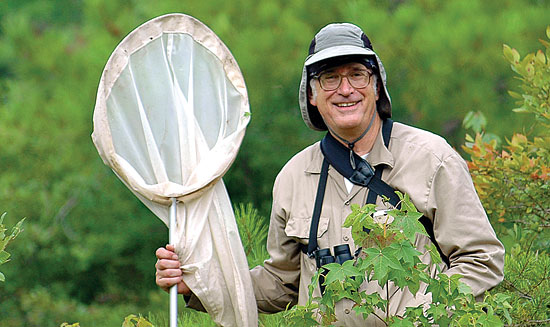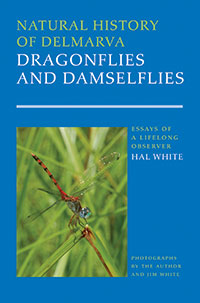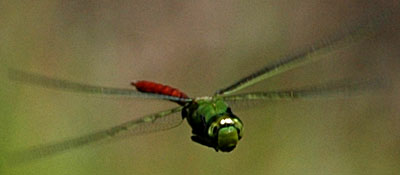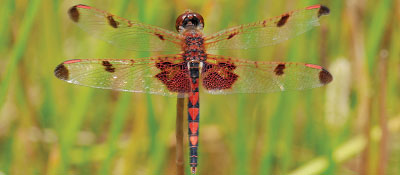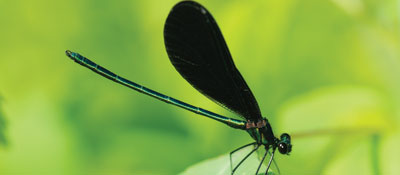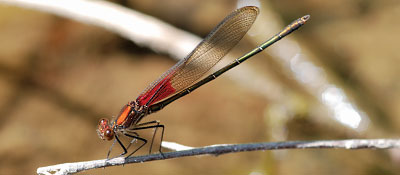A lifelong observer brings the
Wonder of Dragonflies
to light
Hal White prepares for another foray into the swamp. The UD chemistry professor is recognized as Delaware's preeminent authority on dragonflies and damselflies.
Poking along Spring Creek in central Pennsylvania, young Hal White wasn't interested in the lunker brown trout hiding in the riffles of the cool, shaded limestone stream revered by fly fishermen. Rather than an artificial caddis fly deftly cast from a fishing rod, another "fly" caught the boy's eye, glistening in the sunlight.
About two inches long, it had a slender iridescent green body with large green eyes and black wings and fluttered a bit like a butterfly as it flew.
"It turned out to be an ebony jewelwing, a very pretty damselfly," White says. "A friend of mine liked to call them 'Flapdoodles' because of the bouncy, flapping flight they have."
That encounter would mark the beginning of a lifelong hobby for White, who brought his passion for "odeing"— the pursuit of dragonflies and damselflies — with him when he joined the faculty of the University of Delaware Department
of Chemistry and Biochemistry in 1971.
Today, White is not only a highly respected UD professor with interests
in vitamin-binding proteins, biochemical evolution, metabolism and problem-based
learning, he also is recognized as Delaware's preeminent authority on dragonflies
and damselflies. While both insects belong to the order Odonata, dragonflies
are larger and hold their wings open when at rest, compared to the more
petite damselflies, which hold their wings together when resting.
These elegant predators with enormous eyes dart into view along wetlands, ponds and creeks on hot, sunny days, hunting for mosquitoes, gnats and other insect quarry. Delicate, yet powerful, some species can fly for hours above the water's surface.
White brings the wonder of these colorful insects to light in Natural
History of Delmarva Dragonflies and Damselflies: Essays of a Lifelong Observer, published earlier this year by the University of Delaware Press in collaboration with the Delaware Nature Society.
Although well-illustrated with color photographs taken by the author and by UD alumnus Jim White, associate director for land and biodiversity management at the Delaware Nature Society (and no relation to Hal White), the book is not a field guide. In his quest to "write something different," White found inspiration in the fascinating accounts of 19th-century naturalists Alfred Russel Wallace and Henry Walter Bates who traveled to the Amazon on an insect-collecting expedition in 1848. He also read numerous nature books from the 1900s and revisited Rachel Carson's monumental Silent
Spring, which was published in 1962 and is credited with launching the environmental movement in the United States.
In his book, which was over 10 years in the making, White introduces each of the more than 125 species of Odonata from the Delmarva Peninsula with an interesting story, brief essay or anecdote through which he hopes to offer "a broader lesson."
With chapter titles such as "Living Like a Mole" and "Catch Me If You Can," he touches on the concepts of evolution and natural selection, life cycles, behavior, physiology, anatomy, ecology and conservation of dragonflies and damselflies, and introduces readers to how science is done and the people who do it. And he does not overlook the sheer beauty of these flying creatures, intriguingly known as "snake feeders" by some cultures and viewed as symbols of good luck by others.
In "Dragonfly Art," White introduces the Calico Pennant (Celithemis
elisa), a small red dragonfly that often perches facing the wind on the tips of reeds emerging from shallow ponds.
"In my experience, it prefers fishless ponds where its abundance can be quite high, and mass emergences in June can be spectacular natural 'artistic happenings,'" he writes. "Although the Calico Pennant has an appropriate name, some people think that an even better name would have been the Valentine Pennant to call attention to the little red heart-shaped marks on the top of several abdominal segments of the males. Females have similar markings, but their colors are more yellow than red. Regardless of its name, the Calico Pennant would be a good model for any artist."
White has spent lots of weekends wearing a "goofy hat with a veil" to protect himself from the sun and biting flies, a camera and binoculars strung around his neck, bug collecting net in hand. He has explored numerous habitats from White Clay Creek, a National Wild and Scenic River flowing through Newark, Del., to Idylwild Wildlife Management Area in Caroline County, Md., all the way to the marshy islands flanking the entrance to the Chesapeake Bay Bridge-Tunnel on Virginia's Eastern Shore.
"You may wade into a stream and go into mud knee deep and so dark it stains your skin. When I come back from one of my trips, nobody wants to get near me," he says with a broad smile.
Although a little mud doesn't bother White, the state of the environment does deeply concern him. In his book, he pleads for greater awareness and protection of fragile habitats for the future of dragonflies and damselflies — and perhaps for ourselves. If these spritely insects that preceded the dinosaurs can no longer survive, can we be far behind?
"Our seemingly innocent routine activities of building houses, fertilizing lawns and crops, salting roads in the winter, cutting down stream-side vegetation, tapping groundwater supplies, introducing alien plants and many other activities will contribute far more to the demise of certain species than most people realize," White says. "If these vignettes in any way motivate others to prevent the further loss or disruption of wetland and aquatic habitats, the effort will be wholly worthwhile."








